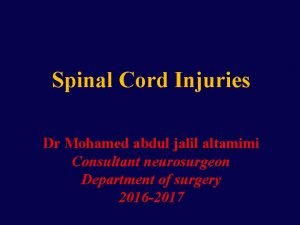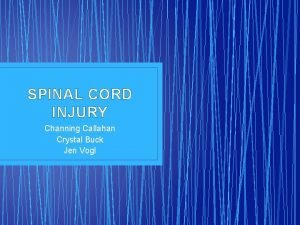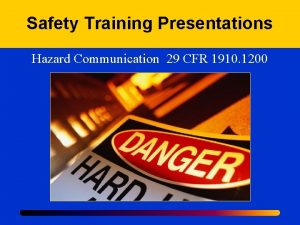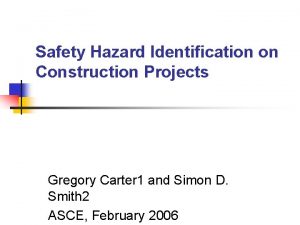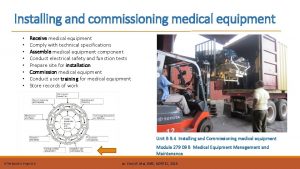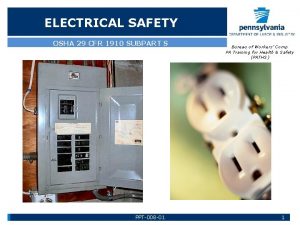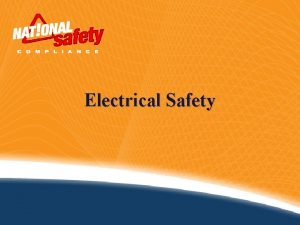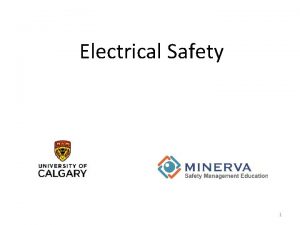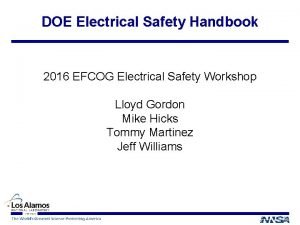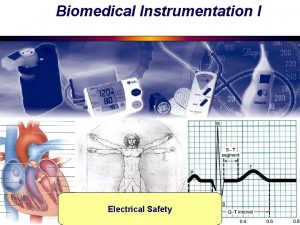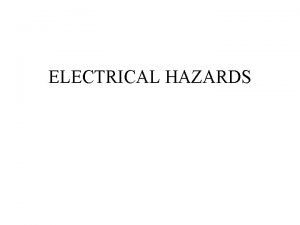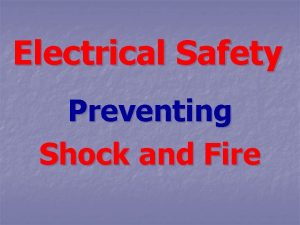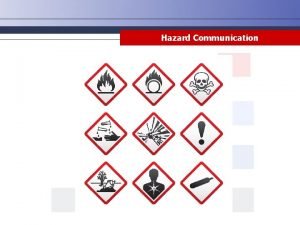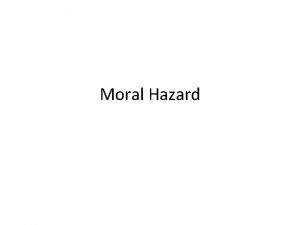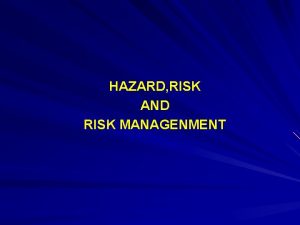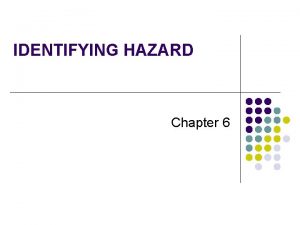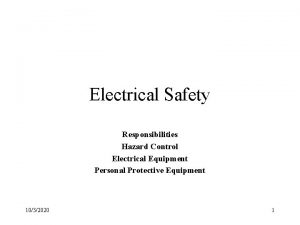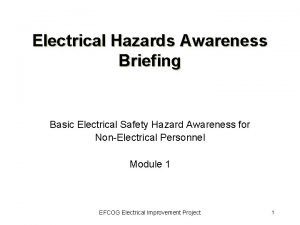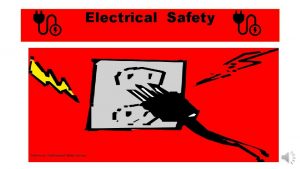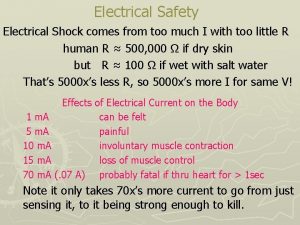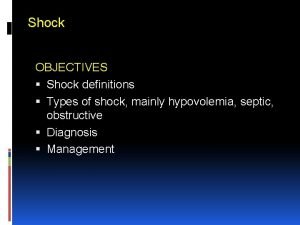Electrical Safety Electric Hazard Electric Shock Electric shock

















- Slides: 17

Electrical Safety

Electric Hazard • Electric Shock – Electric shock is a term that relates to the consequences of current flowing through nerves, muscles and organs of a body. • Effects of Electric Shock – Heating effect of current damages body tissues by burn. – Death could occur when the rhythm of the heart is disturbed such as to effect blood flow. This is known as VENTICULAR FABRILATION.

Electric Hazard Ø Factors Governing Shocks Ø Amplitude of current. Ø Duration of current. Ø Condition of the body. Ø Sex & age of the person. Ø Ambient temperature and humidity. Ø O 2 and CO 2 content in surrounding air. Ø Material / Flooring. Ø Positions of hands and legs. Ø Condition of Earthing.

Electric Hazard Amplitude of Current (m. A) Effect on the body Up to 1 No sensation 1 to 8 Sensation there , but no pain 8 to 15 Painful shock but muscular control still there 15 to 20 Muscular control lost , resulting in sticking 20 to 50 Severe muscular contraction 50 to 200 Ventricular fibrillation or death 200 & above Severe burn and death due to heart attack.

Electric Hazard Causes of Electrical Accidents Ø Poor knowledge of equipments / system. Ø Over confidence. Ø Taking a chance or risk. Ø Hurry to complete the job or charge the equipment. Ø Monkey tricks. Ø Working without concentration.

Electric Hazard Causes of Electrical Accidents Ø Poor maintenance of equipments. Ø Poor quality of tools. Ø Not using PPE’s. Ø Miscommunication. Ø Not following safety procedure. Ø Temporary repairs. Ø Poor earthing.

Hazards of Static Electricity & Its Control

Static Electricity • When dissimilar materials come in contact and separate, (i. e. they are in motion & maintain contact with each other) there is a transfer of electrons from one material to the other material. • The excess of electrons is called negative charge and deficiency of electrons is called positive charge. • When heavy cloud of charge tries to break the air insulation and finds it way to earth , it results into static electricity. When one of the material is non conductor, static charge can accumulate. • Attraction can be measured as potential difference or voltage. • Larger Voltage results in larger spark. • Flow of static electricity causes spark / Explosion in hazardous area.

Static Electricity Source of Generation • Rubbing wool or plastic. • Pouring bulk material out of bag / container. • Unrolling of plastic or PVC film. • Flow of liquid through pipe line. • Spraying of paint on a wall. • Impact of dust particles on a wall. Measurable charge will be created only if one of the materials involved is a non conductor of electricity

Static Electricity Conditions for Accident • Rate of generation is higher than the rate of discharge. • The gas mixture around the spark is flammable. • Accumulated charge is sufficient to cause a spark. • Spark is sufficient to ignite the mixture. • The proportion of flammable mixture is within the explosive limit. (LEL & UEL)

Static Electricity Steps for Controlling • Draining the accumulated charge by bonding and earthing. • Avoid splash filling. • While designing pipe line ‘ Relaxation time’ should be kept in view. • Control Flow / Velocity. (Up to 200 mm diameter pipe, less than 7 meter/second & for higher sizes velocity less than 1. 5 meter / second. ) • Maintain high relative humidity in the atmosphere near material. • Provide nitrogen blanketing. • Provide ionized atmosphere.

Cautions During Work

Static Electricity Control Measures • While Filling Drums and Containers – Do proper earthing. – Avoid splash filling. – Avoid use of non – metallic pipes & drums. – Weighing scale platform should be earthed. – During filling a drum , a small vent should be open to release pressure.

Static Electricity Control Measures • Filling of Storage Tanks – Earthing of tanks , pipeline & pumps should be proper. – Sampling should be carried only after surface turbulence is subsided. – Floating roof tank & inert gas blanketing should be used.

Static Electricity Control Measures • Loading / Unloading Tanker. – Tanker should be earthed first , before opening the dome. – Earth point should be thoroughly cleaned of paints. – Avoid splash filling. – Once tanker is loaded wait for 5 to 10 minutes before removing earthing clamp. – Start unloading after 5 to 10 minutes of connecting earthing. – Lower dip rod after 5 to 10 minutes of connecting earthing.

Electric Hazard Condition of Earthing Ø If earthing is good, protection system will immediately disconnect the faulty equipment. Ø If earthing is not proper , the system will not give any protection against accident.

Displays
 The safest ladder to use around electricity
The safest ladder to use around electricity Spinal shock vs neurogenic shock
Spinal shock vs neurogenic shock Shock normovolemico
Shock normovolemico Spinal shock vs neurogenic shock
Spinal shock vs neurogenic shock T10 spinal cord
T10 spinal cord Subacute combined degeneration of the cord
Subacute combined degeneration of the cord Potensi bahaya listrik (electrical hazard) adalah
Potensi bahaya listrik (electrical hazard) adalah Health unit 1 post test
Health unit 1 post test 29 cfr 1910
29 cfr 1910 Safety hazard identification on construction projects
Safety hazard identification on construction projects Touch current vs leakage current
Touch current vs leakage current Electrical safety analyzer
Electrical safety analyzer Osha 1910 subpart s
Osha 1910 subpart s How electricity works
How electricity works Electrical safety introduction
Electrical safety introduction Doe electrical safety handbook
Doe electrical safety handbook Electrical safety in biomedical instrumentation
Electrical safety in biomedical instrumentation Electrical circuit elements
Electrical circuit elements

